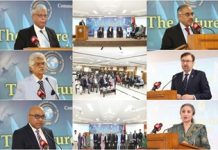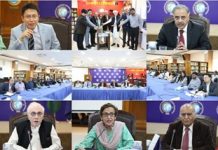Right after some degree of economic satisfaction, people with some history of democratic struggle want the next thing on their hierarchy of desires i.e. freedom and representation in power structures. Failure to accept change in degrees that would satisfy the new social classes can only lead to conflict and confrontation
The college and university students of Pakistan made history in launching the first wave of agitation against Ayub Khan in 1968. The students’ street action and demand for his removal was a surprise for the Field Marshall and many of his supporters as these students were the product of the modernisation his regime had brought about by expanding educational opportunities in almost every field. Why, then, would the students rise against his regime? What did they want? These questions are important because the same situation is emerging again, but the Pervez Musharraf regime is not likely to be nimble enough to grasp this bitter reality.
Let us take the first question. There are many ways to understand modernisation and its economic, industrial and technological impact, and more importantly, the impact these processes have on the lifestyles and aspirations of individuals and groups. Ayub, and interestingly in the same fashion, Musharraf lacked the intellectual capability to understand the social impact of the changes brought about by their respective regimes.
What are these social changes that are associated with development? The most important with respect to the subject at hand is a sense of empowerment: the feeling that one is destined to do things other than doing well in examinations and fitting somewhere in the job market. But this sense of empowerment is both intrinsic to being modern as well as instrumental to bigger ideas of social change, civility in politics and social affairs, justice, rule of law and meaningful civic engagement.
Almost every student movement around the world was driven by these non-partisan sentiments about improving politics, society and state. And their success in every movement was largely due to the fact that the students acted as an autonomous social group and achieved a greater degree of cohesion among them to effectively resist an unwanted regime.
That is true of the student movement against Ayub and might be true to a lesser degree today of the student movement against Musharraf. There is need to understand contextual factors that both movements share to an extent, factors that agitate the minds of young students. Chief among them is the disconnect between social and political aspirations of the students gaining political consciousness during a period of sustained economic growth and the authoritarian political order that takes credit for that growth.
This is exactly the dilemma that three military, authoritarian regimes in Pakistan have faced. They could not comprehend the social and political consequences of economic development. Nor did they have any ideas, plans or vision of how to accommodate the liberal aspirations of the young generation in an era of relative economic prosperity. They rather relied on old-fashion law and order tactics to intimidate and oppress students into submission or de-link them from the general political process.
Generally, students all over the world have marginal interest in politics to the extent of learning how it is played because their primary interest is and should be in preparing themselves for their careers. But that happens when you have a normal society and politics functioning under set and recognised rules of the game.
It is necessary to understand that economic development changes the primary ethos of social groups that benefit from it. In a way, modernisation, even in small measures, is destabilising to the old system. A perfect condition of confrontation may be created in a society with an old elitist political order, which disregards the law and the constitution, and a larger social group like students that has acquired another set of values.
Social groups acquire new values under conditions of economic change, for better or worse, and also in light of global transformations that might raise their expectations or anxieties. The student movement against Ayub took off when the youth felt that the rewards of economic progress were not shared equitably and the system that brought about industrialisation was anti-democratic both in the process as well as in its distributive effects.
Why would students of colleges and universities bother with this? Because they are future stakeholders in the economic and political system of any country, and therefore hold a deep interest in a rule-bound and just system of rewards in society.
There is an international context to both movements as well. The anti-Ayub student agitation took place in times of conflicting ideologies of the Cold War. Young people entering the colleges began to explore different ideas about politics and society, and about change and revolution. Also, it was embedded in the global revolt of the youth against the values of the establishment that the counter-culture movement on American campuses manifested at that time.
What is happening today in some colleges and universities in Pakistan is no different. Its domestic context is the same discontentment with the system held by students of my generation. The global context is different, but perhaps its influence over young people is positively greater than the fuzzy ideas of revolution and revolt in the earlier period. This is the impact of globalisation on cultures, values and attitudes toward the fundamental issues of state and governance. Today, social groups may be divided on what is the best way of achieving the common goal of a good society, but the roots of disaffection are the same, and so is the desire for a positive change.
Responses of the Ayub and Musharraf regimes to student uprisings are remarkably the same: using old-fashioned law and order tactics, fear and oppression to prevent them from expressing their resentment against martial law and emergency rule. Both military leaders failed in understanding why a social class that benefited from economic growth under their rule revolted against them. The reason is simple but not so comfortable to accept: right after some degree of economic satisfaction, people with some history of democratic struggle want the next thing on their hierarchy of desires i.e. freedom and representation in power structures. Failure to accept change in degrees that would satisfy the new social classes can only lead to conflict and confrontation.
Finally, there is a fear about student movements in Pakistan. They have been, and are, vulnerable to the intrusion of political parties. Their success against the Ayub regime invited the entry of all types of parties, from national to ethnic to religious. It is well known how these parties factionalised the students and used their respective student groups to establish dominance on campuses. That ended my generation’s dreams of intellectual freedom, dialogue and tolerance. As long as students are able to keep political parties out of their lives and institutions, they can be a great social force that supports national ideals.
That ended the dreams of my generation to have intellectual freedom, dialogue and debate with tolerance. As long as students are able to keep political parties out of their lives and institutions they can be a great social force in support of national ideals. If they play for the parties they would become fragmented as a social force and a movement as it happened in the earlier decades.
The author is a professor of Political Science at the Lahore University of Management Sciences.












